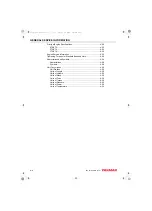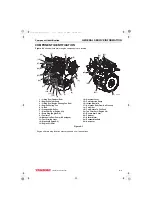
GENERAL SERVICE INFORMATION
TNV IDI Service Manual
4-13
Diesel Fuel
Filling the Fuel Tank
DANGER
FIRE AND EXPLOSION HAZARD!
• Diesel fuel is flammable and
explosive under certain
conditions.
• Only fill the fuel tank with diesel fuel. Filling
the fuel tank with gasoline may result in a fire
and will damage the engine.
• NEVER refuel with the engine running.
• Wipe up all spills immediately.
• Keep sparks, open flames or any other form of
ignition (match, cigarette, static electric
source) well away when refueling.
• NEVER overfill the fuel tank.
• Fill the fuel tank. Store any containers
containing fuel in a well-ventilated area, away
from any combustibles or sources of ignition.
• Be sure to place the diesel fuel container on
the ground when transferring the diesel fuel
from the pump to the container. Hold the hose
nozzle firmly against the side of the container
while filling it. This prevents static electricity
buildup which could cause sparks and ignite
fuel vapors.
• NEVER place diesel fuel or other flammable
material such as oil, hay or dried grass close
to the engine during engine operation or
shortly after shutdown.
• Before you operate the engine, check for fuel
leaks. Replace rubberized fuel hoses every
two years or every 2000 hours of engine
operation, whichever comes first, even if the
engine has been out of service. Rubberized
fuel lines tend to dry out and become brittle
after two years or 2000 hours of engine
operation, whichever comes first.
• Failure to comply will result in death or
serious injury.
NOTICE
• Only use diesel fuels recommended by Yanmar
for the best engine performance, to prevent
engine damage and to comply with EPA / ARB
warranty requirements.
• Only use clean diesel fuel.
• NEVER remove the primary strainer (if equipped)
from the fuel tank filler port. If removed, dirt and
debris could get into the fuel system causing it to
clog.
Note that a typical fuel tank is shown. The fuel tank
on the equipment being serviced may be different.
1. Clean the area around the fuel cap
(Figure 4-3, (1))
.
2. Remove the fuel cap
(Figure 4-3, (1))
from the
fuel tank
(Figure 4-3, (2))
.
3. Observe the fuel level sight gauge
(Figure 4-3, (3))
and stop fueling when gauge
shows fuel tank is full. NEVER overfill the fuel
tank.
4. Replace the fuel cap and hand-tighten. Over
tightening the fuel cap will damage it.
Figure 4-3
0000002A
(1)
(2)
(3)
TNV_IDI_ServiceManual_A4.book 13 ページ 2012年2月24日 金曜日 午前10時24分
















































